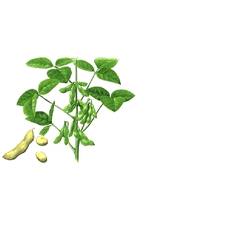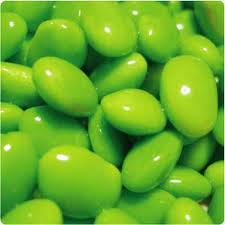Navigation
Soy and Hair Loss
French researchers compared the effects of a soyextract vs. genistein and daidzein (isoflavones devoid of their carbohydrate conjugates) and daidzin and puerarin (carbohydrate conjugated isoflavones; puerarin is present in abundance within kudzu [Pueraria lobata]) on different hormone elements and isolated human hair follicles. 'Activation' of the gene coding for an enzyme implicated in androgenetic hair loss (5alpha-reductase; the target of the drug finasteride, for androgenetic alopecia) was inhibited by both genistein and puerarin. Genetic activation of an enzyme involved in the conversion of testosterone into estrogens (aromatase) was increased by genistein and, to a lesser extent, daidzein. The soy extract stimulated one of the estrogen receptors (b receptor) greater than genistein and daidzein, although the latter two were stimulatory themselves. Receptors for testosterone-like molecules (androgens) were decreased by genistein, and half as much by daidzein. But what does all this molecular hormone 'geek speak' mean? The researchers found a 30 per cent increase in hair growth with the soy extract. Woven together, these data suggest that an isoflavone mixture, perhaps ideally from soy (but yet to be confirmed) could arrest hair loss in conditions where androgens are playing an operative role. Soy Patent for Hair Loss "The present invention is based on the principle that plants and plant extracts containing isoflavones can inhibit hair loss. Plants or plant extracts containing isoflavones can be administered either orally or topically to prevent hair loss. The present invention provides the additional benefit that the administration of isoflavone-containing plants or plant extracts can provide other health benefits in addition to preventing hair loss. Another advantage of the invention is that the isoflavone-containing plants and plant extracts can be combined with other pharmaceutical treatments for preventing hair loss without adversely affecting the beneficial and positive effects of such treatments. "It is a further object of the invention to provide a method of preventing hair loss which may be used orally." "The present invention includes compositions containing isoflavones in general, and particularly soybean isoflavonoids, may be used to prevent hair loss in mammals, including both in men and women, by the aforementioned mechanism of action. Such isoflavones may include, but are not limited to, genistein (II) and variants thereof. Genistein is also termed 5,7-dihydroxy-3-(4-hydroxyphenyl)-4H-1-benzopyran-4-one or 4',5,7-trihydroxy-isoflavone Sources of the preferred isoflavones include soy and other members of the Leguminosae family and the Rosaceae, Podocarpaceae, Iridaceae, Moraceae, Amarantaceae and Compositae families, as will be appreciated by those in the art." The total amount of plant, plant extract, carriers, excipients, diluents, lubricants and other so-called "pharmaceutical aids" included in an oral dosage form may be varied according to the preferred size of the oral dosage form. For capsules, the total weight may range from about 275 mg to about 500 mg, although greater or lesser capsule weights are within the scope of the invention." "In its oral form, the composition may be taken alone or in combination with food or liquids. In the preferred embodiment of the invention, the composition is preferably taken with a meal or with liquid. Generally from 1 to 2 oral doses may be taken in from 1 to 4 or more times a day." Japanese Diet In the US, where pattern loss in epidemic, the daily dietary intake is only 1 to 3 mg. Previously, doctor's thought that the
disproportionate amount of androgen mediated disorders, i.e. prostate cancer, acne, and pattern loss was because of the high fat content of the western diet.
New studies, however, fail to show a significant link between dietary fat and these types of disorders. For the treatment or prevention of pattern hair loss it would be reasonable to consume 300-500 mg. of soy extract (not just protein) a day, preferably in divided doses.
Further Reading Introduction Nature usually has a solution for most health ailments and the problem with hair loss in no exception. Saw Palmetto Natural Propecia Nettles Applying an extract of Nettles to the scalp was said to stimulate hair growth, and chronic rheumatism was treated by placing nettle leaves directly on to the afflicted area. Capsaicin Capsaicin induces the release of substance which is believed to play an important role in murine hair growth and cycle. Soy Extract An American Herb company was recently issued a patent for the use of soy extract for the treatment and prevention of hair loss. Cayenne Pepper Excellent results have been seen with alopecia, male pattern baldness and excellent results also in women that have lost their hair. Proanthocyanidin Natures Minoxidil Pygeum Bark Pygeum africanum a herb derived from the bark of the African evergreen,which inhibits the enzyme 5-alpha-reductase, is widely used in Europe to prevent and treat prostate problems and to prevent and treat male pattern baldness. Sapote In Santo Domingo, the seed kernel oil is used as a skin ointment and as a hair dressing believed to stop falling hair. Aromatherapy Evidently, one or more of the essential oils is able to promote hair regrowth.
An American Herb company was recently issued a patent for the use of soy extract for the treatment and prevention of hair loss.
Following are excerpts from the patent itself.
"The present invention is based on the principle that plants or plant extracts containing isoflavones may be administered orally or topically to prevent hair loss."
"The isoflavones of the present invention include those which exhibit estrogenic activity and which bind to testosterone receptors. Such isoflavones prevent the "hair loss" effect of testosterone by inhibiting the binding of testosterone to the hair and scalp receptor, thereby resulting in maintenance of scalp hair integrity."
"Orally-administrable dosage forms of the invention may include, but are not limited to, capsules, tablets, powders and liquids (hereinafter referred to as "oral dosage forms"). Other equivalent oral dosage forms are within the scope of the invention, as will be readily appreciated by those of skill in the art. As an oral dosage form, the composition may be administered alone or in combination with food."
"In a still more preferred embodiment of the invention, an oral dosage form contains from about 400 to about 500 mg total weight plant or plant extract. In the most preferred embodiment, the oral dosage will contain about 450 mg of isoflavone-containing plant or plant extract.
The rural Japanese, who traditionally have low rates of breast and prostate cancer, and almost no incidence of male pattern balding typically consume 20-80 mg. of genistein a day, a phytochemical almost entirely derived from soy beans.
Many researchers have now concluded that the heightened incidence of these disorders results from a diet that is deficient in soy.
